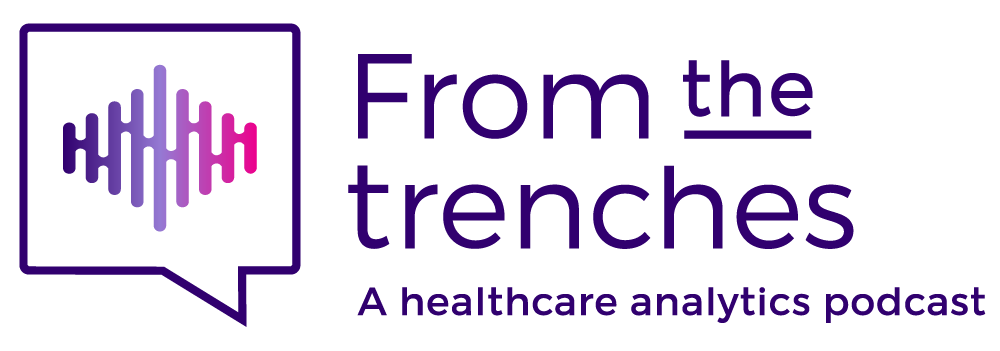Payment accuracy programs are critical to delivering value to health plan members. Some plans excel at recovery management while others struggle—and the difference in financial results is significant. But regardless of size, any health plan can improve its recovery results by pulling a few key levers. On episode 17 of our “From the Trenches” podcast, Chris Mastro, vice president of operations, once again joins Jeremy Bamford, senior product director for payment accuracy, to look at what drives success in recovering claim overpayments.
If you missed part one of this podcast series examining the keys to successful claim overpayment recovery, go back and listen for more insight.
| About the podcast | About our guests |
|---|---|
|
From the Trenches is a healthcare podcast from Cotiviti, a leader in healthcare data analytics, exploring the latest trends in healthcare quality and performance analytics, risk adjustment, payment integrity, and payer-provider collaboration. Check out all our episodes in your browser, or subscribe on your smartphone or tablet with Apple Podcasts, Spotify, Google Podcasts, and many other apps. |
|
Payers know that their goals must cover the entire payment cycle and be consistent across health plan functions to achieve the desired impact. Read our Payment Accuracy solution overview and learn how Cotiviti offers knowledge, insight, and thoroughness.
Podcast transcript
Can you describe how health plans build an ideal retrospective recovery program?
Jeremy: It's really critical to align your recovery program content with your operational process. Quite often we see this is individualized by plan and claim system-specific, so it's not really a one-shoe-fits-all approach. Understanding that throughput and tweaking and designing your process to align with that is really key.
That focuses on a couple of key areas. We've seen success where a lot of plans have focused on that recovery process specifically and clear provider communication, as well as really clear internal metric visibility to hold internal constituents accountable. At a provider level, a clear explanation of the overpayment—especially when concepts get quite complex, more detail is required. Giving that level of specificity to the providers we see drives overall recovery success.
Secondly, optimizing those savings by prioritizing the inventory, obtaining that upfront plan alignment with your concepts and what you're pursuing so you're getting that enterprise visibility and upfront buy-in so there are no surprises. When it does come to the actual collection process, you've really got alignment and more importantly the provider network is on board and supporting that process, especially if there is any pushback or questions on a particular concept—that becomes really key. That upfront alignment is a huge recovery success factor.
Chris: You mentioned prioritizing inventory. What's your perspective on aged inventory and impacts there?
Jeremy: That is a challenge. Obviously the longer it takes to recover a claim, the less likelihood you're going to have of being successful. We've found that by really prioritizing and increasing focus on providers that are stuck in inventory management, you can come up some resolution strategies, partnering with the provider network to really help you resolve those and reduce your backlog of aged inventory.
Lastly, minimizing that overall recovery process timeline is key. Obviously success diminishes over time. Anything greater than 180 days we see as having a very low likelihood of success. That continual monitoring is really key in limiting the amount of key that goes into that bucket.
What are the most impactful drivers of recovery management success?
Jeremy: We actually conducted a study across our entire client portfolio analyzing the root cause and challenges associated with recovery savings at health plans. We found several top drivers or common denominators where plans were really successful.
First, they were focused on claim validation. Successful plans migrated from an individual claim validation process to a more upfront concept buy-in, typically with sampling of claims so you can get a look and feel for the specific issue and do some analysis and QA on those claims, really allowing for scale. We saw this as a huge bottleneck in some plans where individualizing that claim validation process really proved to be a time-consuming event and quite resource intensive. Moving toward a more enterprise concept approval process is really driving what we call auto-validation approval, helping reduce that recovery timeline and driving increased volume through the process. That was a key area of success at a lot of plans.
Chris: One thing we've seen is aging invalidation. Plans typically have resource constraints; it tends to be a common bottleneck both in the recovery cycle but also constraining savings because you're capping your overpayment findings with your capacity to actually validate each claim that comes through manually.
Jeremy: That was something we saw a lot of plans. Another big step forward we saw were those plans that developed and focused on batch offsetting or automated offset processing, again moving away from manual, individual claim adjustments to syncing up with like concepts and focusing on batch adjusting like concept. That way you can sync with the right error codes, root cause codes, and do things in batch rather than individual claims, so again you're eliminating those resource constraints. It's more scalable and accelerates that recovery timeline.
You've talked about offsetting. What do health plans do when offsetting claims isn't an option?
Jeremy: Offsetting, while a great and crisp approach in an accelerated timeline, is not always an option. Quite often, we've seen where either providers have a limited amount of future payments going out the door or there are contractual restrictions at a provider level restricting offsets. Where we've seen plans develop a successful strategy is to supplement that offset process with a manual collection process, so that's really reaching out to the providers and doing a follow-up. Establishing a lockbox helps drive success so there's accountability.
We've seen that those plans that develop that process in addition to their offset capabilities kicked up a gear in terms of overall conversion success. We saw plans with only offset ability teetering around the 70 to 75 percent mark, but those plans that really had that manual process for collections on top of the offset process jumped up to closer to 85 percent. This is hugely successful but requires succinct prioritization and that feedback loop from the health plan to the vendor to manage that recovery process.
Chris: I would add that it's important to manage inventory and manual collections at the provider level. There may be a temptation I've seen where folks will break claims up based on data mining or pharmacy or coordination of benefits and split those out potentially to different recovery partners. Then you have multiple folks all calling the same provider on behalf of the health plan, which can unintentionally create additional provider abrasion and confusion or delay conversion, whereas if you can manage that holistically, it can help with the provider relationship and also accelerate conversion.
How successful have the top health plans been?
Jeremy: First, I'd like to point that it's not just about the large national plans. We've seen success even at smaller plans that have developed a really good, thought-out operational process that aligns with their systems, their people, and their vendor partners.
A good benchmark that we've seen is for plans to recover within a 90-day window (from the time you have an overpayment finding to actually realizing the recovery savings), with a conversion rate (how much the plan actually saves) of greater than 75 percent. Those plans that have done well in those areas again include not just large national plans, but plenty of small plans that have a well thought-out process that have driven great success around those two metrics—aligning to their claims system, their process, and their infrastructure is really key to how they manage their inventory through the cycle.
Chris: As you said earlier, it's not one-size-fits-all. We've seen clients with great performance, speed, and conversion whether they've optimized their concept approval process and have a well-structured good governance process so a claim moves through quickly, or clients have invested on the back end with great auto-batch offset capabilities or cross-platform offsetting to accelerate conversion.
Podcast music credit: "Inhaling Freedom" by Nazar Rybak, HookSounds.




 Chris Mastro leads the enterprise yield management team at Cotiviti, focusing on recovery process optimization, improving the provider experience, and accelerating conversion for clients. He is currently focused on improving client inventory management through Lean/Six Sigma and automated workflow solutions.
Chris Mastro leads the enterprise yield management team at Cotiviti, focusing on recovery process optimization, improving the provider experience, and accelerating conversion for clients. He is currently focused on improving client inventory management through Lean/Six Sigma and automated workflow solutions. Jeremy Bamford is a senior product director supporting Cotiviti's retrospective payment accuracy solutions. He has been a key part of Cotiviti's retrospective team for more than 17 years. Jeremy has spent the last 12 years specializing in Medicare managed care audit operations.
Jeremy Bamford is a senior product director supporting Cotiviti's retrospective payment accuracy solutions. He has been a key part of Cotiviti's retrospective team for more than 17 years. Jeremy has spent the last 12 years specializing in Medicare managed care audit operations.



